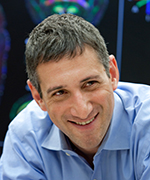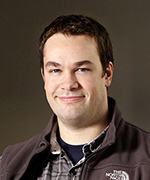Colleagues: Recently Tenured
DIANE L. DAMIANO, PH.D., P.T., CC
Senior Investigator and Chief, Functional and Applied Biomechanics Section, Rehabilitation Medicine Department, NIH Clinical Center

Education: Catholic University of America, Washington, D.C. (B.A. in biological sciences); Duke University, Durham, N.C. (M.S. in physical therapy); University of Virginia, Charlottesville, Va. (Ph.D. in biomechanics and research design)
Before coming to NIH: Associate professor of orthopedics on tenure track, University of Virginia (Charlottesville); research associate professor of neurology and adjunct professor of physical therapy, Washington University (St. Louis)
Came to NIH: In 2008
Selected professional activities: Past president of the American Academy of Cerebral Palsy and Developmental Medicine; member of editorial boards of Neurorehabilitation and Neural Repair, Developmental Medicine and Child Neurology, and the Journal of Pediatric Rehabilitation
Outside interests: Hiking; jogging; playing tennis; traveling
Website: https://irp.nih.gov/pi/diane-damiano
Research interests: My scientific career path has been somewhat unusual in that I was in my late 30s when I started my Ph.D. and never did a postdoctoral fellowship. Before that, I was a pediatric physical therapist for 12 years and worked with children who had cerebral palsy (CP) and other physical disabilities. The prevailing clinical wisdom at the time (1980s) was that anyone with a brain injury—such as CP or stroke—should not strengthen their muscles because it would increase their spasticity. However, it was obvious to me that these children had poor muscle development and were weak. They seemed to worsen with age because their muscles could not keep up with their increased physical growth.
So for my Ph.D. thesis I decided to challenge the prevailing dogma and conducted a small clinical trial of progressive-resistance weight training in children with CP. It worked. The children all had marked increases in leg strength, and even after a few weeks several were starting to demonstrate improvements in their ability to walk; one child was able to run for the first time (running requires more strength than walking). Because I was one of the first researchers to recognize and quantify that muscles in patients with spasticity were, in fact, weak and needed strengthening, my research attracted a lot of attention in the rehabilitation field. Immediately after the University of Virginia awarded me my Ph.D., they hired me as an assistant professor of orthopedics and as the research director of UVA’s Motion Analysis and Motor Performance Laboratory.
Today at NIH, I am continuing my work on the role of physical activity in enhancing motor coordination and promoting muscle and neural recovery in those with brain injuries. We are also pioneering the use of noninvasive mobile brain-imaging technologies such as electroencephalography and near-infrared spectroscopy to compare the brain mechanisms underlying motor coordination in children with CP with those of children who are developing normally.
More recently, my laboratory has been developing and testing novel training devices, such as a powered (either with an external motor or by electrical muscle stimulation) exoskeleton, to improve functional mobility in people with CP. Our short-term goal is to enhance their movement capabilities by providing only a small amount of assistance. Our long-term goal is to exploit the inherent plasticity in the brain and in muscles for more permanent and sustainable functional gains.
GUANG HU, PH.D., NIEHS
Senior Investigator, Stem Cell Biology Group, Epigenetics and Stem Cell Biology Laboratory, National Institute of Environmental Health Science

Education: Fudan University, Shanghai, People’s Republic of China (B.S. in biochemistry); Baylor College of Medicine, Houston (Ph.D. in biochemistry and molecular biology)
Training: Postdoctoral fellowship at Brigham and Women’s Hospital (Boston)
Came to NIH: In 2009
Selected professional activities: NIEHS Epigenomics Core Governance Committee
Outside Interests: Doing photography; reading science-fiction novels; playing table tennis
Website: https://irp.nih.gov/pi/guang-hu
Research interests: We study embryonic stem cells (ESCs), which are cells derived from the inner mass of the blastocyst-stage embryo. ESCs have two defining characteristics: self-renewal and pluripotency. Self-renewal describes ESCs’ capability to go through cycles of cell division and maintain the undifferentiated state. Pluripotency describes their capability to differentiate into all cell types found in the adult body. Due to these unique properties, ESCs hold great promises for both basic and translational research. In addition, ESCs may also provide new tools and insights for environmental health sciences.
The long-term goal of our research is to better understand the molecular mechanisms that regulate ESC self-renewal and pluripotency. We have previously carried out a genome-wide genetic screen in mouse ESCs and identified a list of novel regulators of ESC self-renewal. We have since investigated the function of several of the identified factors in ESCs, cell reprogramming, and mouse embryonic development. We found that these factors regulate which genes are turned on in pluripotent cells through transcriptional and post-transcriptional mechanisms.
In future research, we will use a combination of genetic, genomic, and biochemical approaches to continue to investigate ESC self-renewal and pluripotency. By understanding how pluripotent stem cells differentiate into various cell types, we hope to provide new insights into how mammals develop and to advance the field of regenerative medicine. Our findings may also aid the establishment of novel cell-based models for developmental toxicology and environmental-health sciences studies.
PREPARED BY ROBIN ARNETTE, NIEHS
YINLING HU, PH.D., NCI-CCR
Senior Investigator and Head, Inflammation and Tumorigenesis Section, Cancer Inflammation Program; National Cancer Institute-Center for Cancer Research

Education: Institute of Epidemiology and Microbiology, Chinese Academy of Medical Sciences, Beijing (B.S. in biology); Peking Union Medical College, Institute of Virology, Beijing (M.S. in medicine); Melbourne University, Ludwig Institute for Cancer Research, Melbourne, Australia (Ph.D. in molecular biology)
Training: Postdoctoral fellow, Peter MacCallum Cancer Institute (Melbourne); postdoctoral fellow in pharmacology, University of California (San Diego)
Before coming to NIH: Assistant professor, University of Texas MD Anderson Cancer Center Science Park (Smithville, Texas)
Came to NIH: In 2008
Selected professional activities: Member of editorial boards for Journal of Genetic Syndromes and Gene Therapy and Journal of Inflammation and Cancer; training students
Outside interests: Hiking and engaging in other outdoor activities; enjoys playing with her dogs
Website: https://irp.nih.gov/pi/yinling-hu
Research interests: My lab is trying to understand the physiological activities of I-kappa-B kinase alpha (IKK-alpha) in skin, lung, and esophageal tumorigenesis and inflammation and reveal the mechanisms by which IKK-alpha regulates these functions. We use molecular biology approaches and genetic animal models, including Ikk-alpha conditional knockout, Ikk-alpha kinase inactive knockin, and Ikk-alpha transgenic mice.
Decreased expression of IKK-alpha has been reported in a large percentage of human squamous-cell carcinomas (SCC). The Cancer Genome Atlas genomic sequencing data show many mutations and deletions in a high proportion of human skin SCCs and melanomas and in a broad spectrum of other human cancers. In our experiments with mice, we demonstrated that IKK-alpha is a tumor suppressor in these cancers.
We revealed the molecular mechanisms underlying IKK-alpha-mediated pathways in tumorigenesis. We reported that, in the epithelial cells, IKK-alpha induces a cell-cycle arrest and upregulates the expression of a cell-cycle checkpoint protein in response to DNA damage and represses epidermal growth factor receptor activity in a cell-differentiation and proliferation program. Moreover, we have demonstrated that a reduction in IKK-alpha elevates tumor-microenvironmental inflammation.
Recently, we found that IKK-alpha plays a critical role in infection-associated skin and esophageal carcinogenesis. We are trying to figure out how environmental microbiota become pathogenic for human carcinogenesis when the host immune system is impaired. Our goal is to help the prevention, diagnosis, and therapeutic treatment of these human cancers.
DANIEL S. REICH, M.D., PH.D., NINDS
Senior Investigator and Chief, Translational Neuroradiology Section, National Institute of Neurological Disorders and Stroke

Education: Yale University, New Haven, Conn. (B.S. in mathematics and physics); The Rockefeller University and Weill Medical College of Cornell University, New York (M.D. and Ph.D. in visual neurophysiology)
Training: Residency in neurology/diagnostic radiology/neuroradiology at Johns Hopkins Hospital (Baltimore)
Came to NIH: In 2009
Selected professional activities: Elected member of the American Society for Clinical Investigation; serving as federal liaison to several nonprofit-foundation advisory boards; hosting congressional and cabinet-level visitors to NIH; co-organized a meeting celebrating 40 years of neuroimmunology at NINDS (2015); established the North American Imaging in Multiple Sclerosis cooperative (2012); participated in the NIH Celebration of Science (2012); was awarded the National Multiple Sclerosis Society’s Barancik Prize for Innovation in Multiple Sclerosis Research (2016)
Outside interests: Playing chamber music (violin and viola); traveling with his family; running; biking
Website: https://irp.nih.gov/pi/daniel-reich
Research interests: Our lab’s major goal is to understand the pathobiology of multiple sclerosis (MS) through the use of advanced magnetic-resonance imaging (MRI) methods and correlative histopathological techniques. We focus on methods that can be translated to patient care and used as outcome measures in clinical trials of new drugs to treat aspects of MS, for which there is currently no therapy, such as demyelination and neurodegeneration.
Over the past few years, we have been interested in the spatiotemporal dynamics of lesion formation and repair in the white matter, which we study using ultra-high-field (7 tesla) MRI both in people with MS and in animals induced to have a disease that very much resembles MS. We have elucidated the timing and conditions required for the failure of early repair of inflammatory demyelination in the brain and have proposed several trial designs to test therapies that might enhance that repair. We are currently focused on ways to detect and treat chronic inflammation in both gray and white matter.
To translate the discoveries made in the lab, we partner with the NINDS Neuroimmunology Clinic, the trans-NIH Nuclear Magnetic Resonance Center, and the Clinical Center Department of Radiology and Imaging Sciences. We also collaborate with other research groups on campus that study diseases involving inflammation of the central nervous system, for which our imaging methods might prove helpful.
R. SCOTT WILLIAMS PH.D., NIEHS
Senior Investigator, Genome Stability Structural Biology Group, Genome Integrity and Structural Biology Laboratory, National Institute of Environmental Health Sciences

Education: University of Calgary, Calgary, Alberta, Canada (B.Sc. in cellular, molecular, and microbial biology); University of Alberta, Edmonton, Alberta, Canada (Ph.D. in biochemistry)
Training: Postdoctoral fellowship at the University of Alberta; postdoctoral fellowship at The Scripps Research Institute (La Jolla, Calif.)
Came to NIH: In 2009
Selected professional activities: Member, American Chemical Society; member, Faculty of 1000 Medicine
Outside Interests: Playing tennis; mountain biking
Website: https://irp.nih.gov/pi/robert-williams
Research Interests: My group and I examine how cells recognize and repair DNA-strand breaks. The failure to resolve damage at DNA ends that occurs in inherited human diseases is linked to accumulation of mutations in our DNA, neurological disease, aging, and cancer. We use a multipronged approach that integrates biochemical, mutational, and structural analyses of proteins and protein-DNA complexes. In particular, molecular-structural studies involving X-ray crystallography form the bedrock of our work. Overall, we aim to identify and characterize the cellular DNA-damage recognition, signaling, and reversal processes that act as the first line of defense against environmental factors (for example, chemicals and DNA-damaging radiation) that result in DNA breakage.
Current work in the laboratory is aimed at deciphering the functions of DNA end-processing factors tyrosyl-DNA phosphodiesterase 2 (TDP2), aprataxin (APTX), and CtIP/Ctp1 tumor suppressor. Defects in processes we study destabilize the genome and alter organismal functions and susceptibility to genotoxic stressors. They are also linked to human diseases that progress over a lifespan. For example, TDP2 mutations are found in individuals who have intellectual disabilities, seizures, and lack of muscle coordination known as ataxia. Deficiencies in APTX cause difficulty in walking and in controlling eye movements seen in ataxia with oculomotor apraxia 1. CtIP mutations are linked to Seckel syndrome, a rare disease characterized by extremely short stature, small brain, and other birth defects. We envision that a detailed molecular understanding of genome-repair mechanisms will lead to the development of novel cancer treatments and other DNA-targeted chemotherapeutics.
This page was last updated on Tuesday, April 12, 2022
